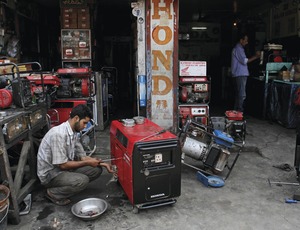
The blackout that swept through the northern and eastern regions of India on July 30 and 31 demonstrated the huge gap between growing demand for electricity and supply as well as political tensions between the state and central governments.
But it also highlighted the opportunities for engineering and construction firms that can provide their expertise, sources say.
"The demand for the technical knowledge, modern tools and practices, and project execution and project management skills that are being pioneered by U.S. firms are critical to the successful upgrade of India's power infrastructure," says Anad Pattani, associate vice president of Overland Park, Kan.-based Black & Veatch's global energy business.
The former power minister of India, Sushil Kumar Shinde, attributed the blackouts to state governments in certain regions of India which he said took more than their allotted share of power from the electrical grid.
Shinde was promoted to home minister on July 31, and a new power minister, Veerappa Moily, was appointed to lead the effort in reforming India's power system. Additionally, CEOs of key federal organizations—including the Central Electricity Authority (CEA), the Power Grid Corp. of India Ltd. (PGIL) and Power System Operator—have been named to a task force charged with submitting a report on the power failure in the coming weeks.
Although the root cause of the failure has not been determined officially, sources say a combination of factors likely led to three of the nation's power grids to shut down, plunging 700 million people into darkness. An inadequate, inefficient electrical infrastructure system and illegal grid connections are the leading culprits.
"The Indian government faces complex issues related to improving the efficiency of its grid, including the demand-supply gap in generation, coal and gas-fuel supply bottlenecks, delays in permitting to build new generation, transmission bottlenecks, high transmission and distribution losses, and other market dynamics," Pattani says.
Allen Gale, managing director of New York-based Parsons Brinckerhoff's India operations, points to the inability of India's power infrastructure to meet rapid demand. In New Delhi alone, demand has increased by 25% in just three years, he says. That presents "great opportunities" for firms that work in the power generation, transmission or supply, he says.
The economy is expected to grow by 6.5% in 2012, possibly to 7% to 8% in 2013, Gale says. "That's a really significant increase in demand."
Nevertheless, sources acknowledge that there are limits to what engineers can do. Key roadblocks include the regulatory hurdles projects must surmount before they can get started, Gale says. Moreover, without sufficient financing, projects won't get built.
Peter Donalek, a senior consultant for electric-power systems at Broomfield, Colo.-based MWH Global, notes that engineers can do only so much within the political system. "There is this boundary between what the engineers can do and the policymakers who establish the rules—there's a tug-of-war that goes on."
Donalek adds that India has been in the process of upgrading its grid for several years. "They're going through a process not dissimilar to what the United States has been doing since deregulation" in the 1990s, he says.
Still, the process to upgrade the grid to meet demand will not be easy, officials say. "In the near term, it's going to be a major challenge," Gale says.


Post a comment to this article
Report Abusive Comment